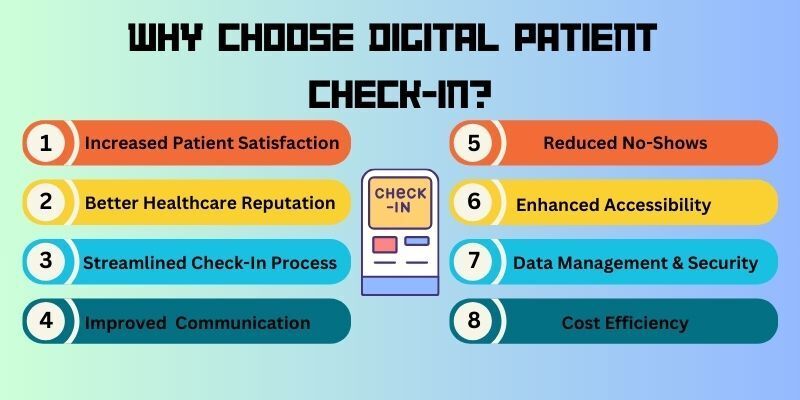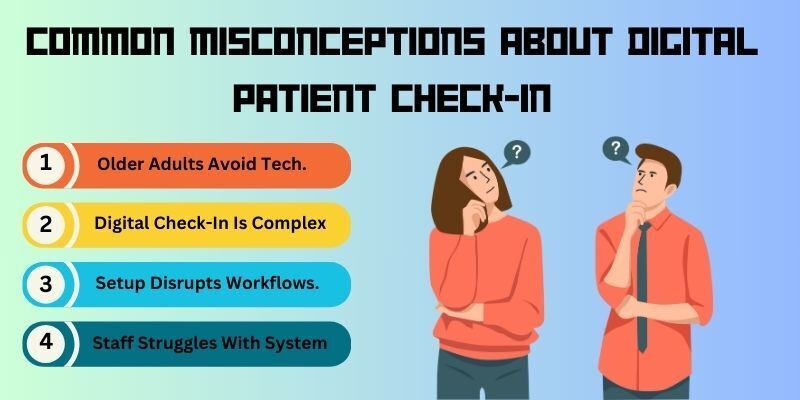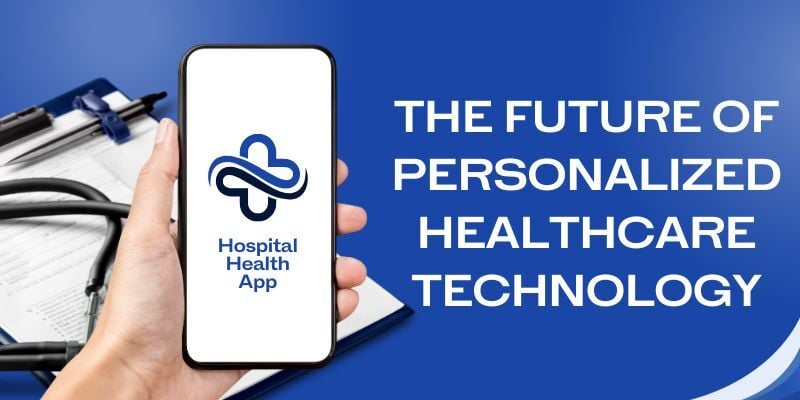The registration process for healthcare appointments has traditionally involved filling out paperwork and long waits in crowded waiting rooms.
But today, digital patient check-in offers a modernized, efficient alternative that allows patients to check in for appointments from the comfort of their homes or anywhere they can access a device.
With this technology, patients can complete registration forms, upload necessary documents, and even make payments beforehand, significantly reducing time spent in waiting rooms.
Not only does digital patient check-in improve the overall digital patient experience, but it also brings significant operational benefits to healthcare providers.
Clinics and hospitals can process patients faster, reduce administrative burdens, and maintain a more organized daily flow. This leads to improved patient satisfaction and a more efficient healthcare system.
The demand for digital solutions in healthcare has risen sharply, particularly following the COVID-19 pandemic, which highlighted the need for contactless services.
Digital solutions like e-registration in healthcare and digital patient engagement tools have become essential. They allow healthcare providers to meet patient expectations while optimizing their internal operations.
This shift improves patient experience and boosts healthcare providers’ overall reputation and efficiency.
What is Digital Patient Check-In?
 Digital patient check-in refers to a system that enables patients to register for healthcare appointments using digital platforms such as mobile phones, tablets, or computers.
Digital patient check-in refers to a system that enables patients to register for healthcare appointments using digital platforms such as mobile phones, tablets, or computers.
This process can be completed remotely, allowing patients to avoid the usual paperwork required at the front desk. Whether patients check in virtually from home, work, or the waiting room, this system significantly reduces the time and stress associated with traditional check-ins.
The functionality of digital patient check-in systems goes beyond simply registering for appointments. Many systems include mobile check-in, automated appointment reminders, and integration with telehealth services, which allow for virtual consultations.
Patients can access these systems through a secure portal on self-service kiosks, complete necessary forms, and even submit their insurance information beforehand.
This reduces manual data entry by healthcare staff and ensures all patient information is available before the appointment.
This system allows healthcare providers to optimize workflow, minimize errors, and improve the overall digital patient intake process. Healthcare providers can make the check-in process smoother for patients and staff by offering a secure, user-friendly platform.
In addition to improving efficiency, these systems can integrate with existing electronic health records (EHRs), ensuring smooth communication between different parts of the healthcare system.
Benefits of Digital Patient Check-In
 A digital patient check-in system can transform healthcare providers’ management of appointments and patient interactions. Below are several key benefits that both patients and healthcare providers can experience by adopting this technology.
A digital patient check-in system can transform healthcare providers’ management of appointments and patient interactions. Below are several key benefits that both patients and healthcare providers can experience by adopting this technology.
1. Increased Patient Satisfaction
Digital patient check-in provides a level of convenience that patients highly appreciate. Instead of arriving early to fill out forms, patients can complete these tasks at their own convenience, from home or any other location.
This process significantly reduces wait times when patients arrive at the clinic, making the entire experience faster and more efficient.
Patients also appreciate the user-friendly nature of digital self-service check-in platforms. These systems are designed to cater to a wide range of demographics, including older adults who may need to become more familiar with technology.
Many check-in systems feature simple interfaces with step-by-step instructions, making it easy for even the least tech-savvy individuals to complete the process.
The ability to check in remotely also helps reduce anxiety, as patients can arrive knowing that much of the administrative work has already been completed.
2. Improved Healthcare Reputation
Healthcare providers implementing digital patient check-in are committed to modern, patient-centered care.
Adopting these technologies improves the overall digital patient experience and boosts the provider’s reputation as a forward-thinking, tech-savvy practice.
Patients are more likely to choose and recommend healthcare facilities that offer convenient, digital solutions that save them time and hassle.
Positive patient experiences are a powerful driver of a healthcare facility’s reputation. Satisfied patients are more likely to leave positive reviews on platforms such as Google or health-specific review sites, which can help attract new patients.
Additionally, online check-in for healthcare shows that a practice values efficiency and patient convenience, which is becoming increasingly important in a competitive healthcare market.
3. Streamlined Check-In Process
Traditionally, the check-in process involved paperwork, manual data entry, and often long waits in crowded waiting rooms.
With digital patient check-in, this cumbersome process is replaced by a more modernized, automated approach. Patients can complete all necessary forms before arriving at the clinic, reducing the burden on front desk staff and minimizing human error.
Moreover, digital patient check-in systems store patient information electronically, ensuring that all data is readily accessible by the healthcare team.
This leads to faster, more efficient processing of patients on the day of their appointment. It also simplifies record-keeping and eliminates the need for physical storage of documents, which is both costly and inefficient.
4. Improved Doctor-Patient Communication
Another major benefit of digital patient check-in is improved communication between patients and their healthcare providers. Many systems include pre-visit questionnaires that allow patients to provide important information before their appointment.
This gives doctors more time to review the patient’s history and current health concerns, leading to more informed consultations.
Additionally, secure messaging platforms, often integrated with digital patient check-in systems, facilitate ongoing communication between patients and providers.
Whether patients have follow-up questions after an appointment or need to clarify instructions, these platforms enable smooth communication that increases overall digital patient engagement.
5. Reduced No-Shows
No-shows are a common challenge for healthcare providers, leading to wasted time and resources. However, digital self-check-in solutions often include automated appointment reminders, significantly reducing the likelihood of patients forgetting their appointments.
Patients can receive reminders via text, email, or app notifications, and they can confirm or reschedule appointments with just a few clicks.
Digital patient check-in systems make rescheduling easier, encouraging patients to keep their appointments or reschedule in advance rather than simply not showing up.
This helps healthcare providers maintain a steady flow of appointments and reduces the disruptions caused by no-shows.
6. Enhanced Accessibility
Digital patient check-in systems are designed to be accessible to a wide range of patients, regardless of their location or device preference.
These platforms are typically compatible with smartphones, tablets, and desktop computers, allowing patients to check in wherever they have internet access.
This is particularly beneficial for busy patients who may need more time to arrive early for appointments or who prefer to complete paperwork remotely.
Furthermore, many digital patient check-in systems are designed to meet the accessibility standards set by the Americans with Disabilities Act (ADA), ensuring that patients with disabilities can use these systems without difficulty.
By providing an inclusive experience, healthcare providers can improve digital patient engagement across diverse patient populations.
7. Better Data Management and Security
Data security is a top priority in healthcare, and digital patient check-in systems are built with this in mind.
These systems utilize encryption and other security measures to protect sensitive patient information, ensuring that data is only accessible to authorized personnel.
This reduces the risk of data breaches and ensures compliance with regulations like the Health Insurance Portability and Accountability Act (HIPAA).
Additionally, by storing patient data electronically, healthcare providers can update their data management processes.
Patient records are organized in a central repository, making it easier for providers to access, update, and share information as needed. This reduces errors and improves the quality of care patients receive.
8. Cost Efficiency
Switching to web-based patient check-in systems can lead to significant cost savings for healthcare providers. Traditional check-in processes often require extensive paperwork, printing, and administrative resources.
By automating these tasks, healthcare providers can reduce the costs of paper forms, storage, and manual data entry.
Moreover, digital patient check-in systems allow healthcare staff to focus on higher-value tasks, such as patient care and customer service, rather than spending time on administrative work. This shift in focus can lead to increased productivity and better patient and provider outcomes.
Overcoming Common Misconceptions
 Despite the clear benefits of digital patient check-in, some misconceptions persist. One common myth is that older adults are not comfortable using digital technology.
Despite the clear benefits of digital patient check-in, some misconceptions persist. One common myth is that older adults are not comfortable using digital technology.
However, studies show seniors increasingly adopt technology, especially when it improves convenience and reduces stress. Many seniors appreciate the ability to check in remotely and avoid the hassles of paperwork and long waits.
Another misconception is that implementing a digital patient intake system is complex and disruptive. While transitioning to digital systems may require initial setup and staff training, many healthcare providers have found the process smoother than expected.
Once implemented, these systems offer long-term benefits far outweigh any initial challenges. With the proper planning and support, healthcare providers can integrate digital self-check-in systems into their workflows with minimal disruption.
FAQs
What is a digital patient check-in?
Digital patient check-in is a process where patients use their devices, such as smartphones or computers, to complete the registration process for healthcare appointments remotely. It eliminates the need for paper forms and allows for a more efficient intake process.
How does a digital check-in work?
Patients receive a link or login to a healthcare provider’s portal to complete the check-in process before their appointment. They provide the necessary information, answer pre-visit questions, and may even submit insurance details and copays electronically.
How long does it take to check in a patient digitally?
The digital check-in process typically takes a few minutes. Patients can complete the registration and necessary forms online, which speeds up the process significantly compared to in-person check-ins.
What are the disadvantages of online check-in?
While digital patient check-in systems offer numerous benefits, some patients may experience technical difficulties or need to become more familiar with the technology. Ensuring a user-friendly platform and offering support can help address these challenges.
What information do you need for a digital check?
Patients typically need to provide their details, insurance information, and answers to pre-visit questionnaires. Some systems may also request copayments or other administrative details during check-in.
Conclusion
Digital patient check-in systems provide many benefits for patients and healthcare providers. From increased patient satisfaction to improved operational efficiency, these systems offer an efficient approach to healthcare registration that reduces the burden on patients and staff.
Healthcare providers looking to improve their digital patient engagement and practice efficiency should consider implementing digital patient check-in solutions.
These tools improve the overall digital patient experience and help providers stay competitive in a rapidly evolving healthcare landscape.
BOOK A FREE DEMO





